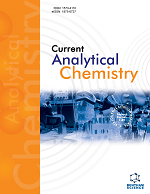- Home
- A-Z Publications
- Current Analytical Chemistry
- Previous Issues
- Volume 19, Issue 1, 2023
Current Analytical Chemistry - Volume 19, Issue 1, 2023
Volume 19, Issue 1, 2023
-
-
Advanced Plasmonic Nanosensors for Monitoring of Environmental Pollutants
More LessAuthors: Duygu Çimen, Nilay Bereli and Adil DenizliBackground: Water is polluted daily with biological and chemical toxins that can seriously threaten human health, animals and ecosystems. The regular identification and monitoring of biological and chemical toxins in water resources are the first steps of the preventive method. The devices used in traditional detection methods such as adsorption and chromatography combined with mass spectrometry are not easy to transp Read More
-
-
-
Oligonucleotide-conjugated Nanomaterials as Biosensing Platforms to Potential Bioterrorism Tools
More LessAvailing diseases as warfare began before humans learned that microorganisms are involved in the dissemination of infections. In the past, war brigades had the intention to weaken rival groups by using festering corpses with the premeditated purpose of causing disease. Nowadays, the unfortunate improvement of biowarfare is indubitably linked to our extensive collaborative work in exploring the use of microorganisms Read More
-
-
-
Graphene-based Nanomaterials for Electrochemical Sensing of Hydrazine: A Short Review
More LessAuthors: Manorama Singh, Smita R. Bhardiya, Ankita Rai and Vijai K. RaiBackground: Hydrazine is a well-known hepatotoxic, mutagen, and carcinogen. It adversely affects not only the liver, DNA, and kidney but the central nervous system also. As per the record of the Environmental Protection Agency (EPA), the United States, the optimum concentration of it has been permitted in sewage and industrial and agricultural effluents is 0.1 ppm. Therefore, monitoring hydrazine concentration is esse Read More
-
-
-
Sustainable and Renewable Nano-biocomposites for Sensors and Actuators: A Review on Preparation and Performance
More LessBackground: Nanomaterials derived from sustainable and biodegradable polymers are currently the most attractive materials. Polymeric nano-biocomposites (PNBCs) are a specific class of materials derived by combining nanosized fillers with polymer materials, and the most commonly used nano-fillers are hydroxyapatite, organic or inorganic metal nanoparticles, clays, etc. Methods: Many recent research works have fo Read More
-
-
-
Investigation of Carbon Nanotube Metal Zinc Oxide Nanoparticle Synthesis and its Applications
More LessAuthors: K. Viswanathan, T. Ravi, D. Ramachandran and A. ThirugnanasambandamBackground: In this study, Carbon Nanotubes (CNT) were synthesized by the CVD method at 950°C. CNT and metal ZnO nanocomposites synthesized by ball mill procedure were examined. Stability of nanocomposite was attained by cationic Ion Liquid (IL), 1-tetradecyl-3 methylimidazolium chloride, structural morphology material characterized by Fourier Transform Infrared (FTIR) spectroscopy, Field Emis Read More
-
-
-
Advances in the Applications of Capillary Electrophoresis to Tobacco Analysis
More LessAuthors: Zhenjie Li, Qianyu Wu, Xinle Zhang and Gang ChenBackground: Capillary electrophoresis (CE) has found a wide range of applications because of its high separation efficiency, low expense, short analysis time and minimal sample volume requirement. The tobacco quality depends on the nature and quantity of numerous substances. CE has been applied in the constituent analysis of tobacco and tobacco products for quality control and research. Methods: The advances in the Read More
-
Volumes & issues
-
Volume 21 (2025)
-
Volume 20 (2024)
-
Volume 19 (2023)
-
Volume 18 (2022)
-
Volume 17 (2021)
-
Volume 16 (2020)
-
Volume 15 (2019)
-
Volume 14 (2018)
-
Volume 13 (2017)
-
Volume 12 (2016)
-
Volume 11 (2015)
-
Volume 10 (2014)
-
Volume 9 (2013)
-
Volume 8 (2012)
-
Volume 7 (2011)
-
Volume 6 (2010)
-
Volume 5 (2009)
-
Volume 4 (2008)
-
Volume 3 (2007)
-
Volume 2 (2006)
-
Volume 1 (2005)
Most Read This Month
Article
content/journals/cac
Journal
10
5
false
en


